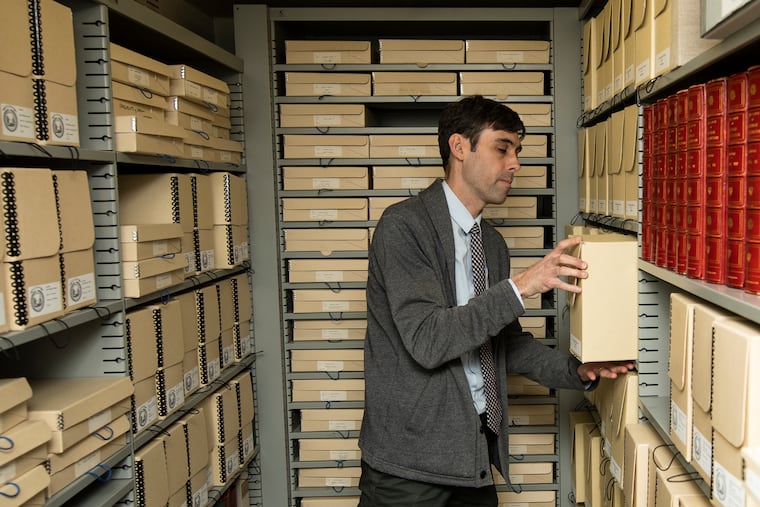American Philosophical Society and David Library join to create a center for study of the revolutionary era
The library has moved its operations into the Philosophical Society to create one-stop shopping for researchers into the American revolutionary era.

Stephen Fried, who teaches writing at Penn and has done a fair amount of it himself, is a firm believer in the David Library of the American Revolution, a scholarly research center in Washington Crossing.
Yes, the David Library has an astonishing collection, he said, but just as important, it exudes an atmosphere of enthused engagement that’s hard to find in libraries these days. Fried encountered that while working on a 2018 biography of Benjamin Rush, the most famous doctor in America at the end of the 18th century.
“It was one of the few places that found out that I was doing a book on Rush and they reached out to offer help," Fried recalled. “It was a great experience … And when the book came out, they called and said, ‘You’ve got to come up.’ It was an event. People are really into it. It’s like a campus."
Now that campus — 118 acres of farmland and about a dozen or so buildings — is being sold and the research activities that thrived along the Delaware River in Bucks County are moving lock, stock, and barrel of microfilm south to Philadelphia.
After years of talks, the David is partnering with the venerable American Philosophical Society, at Fifth and Chestnut Streets, and the resulting David Center for the Study of the American Revolution will be “a powerhouse” nationally for the study of all things related to the Revolutionary era, said Patrick Spero, director of the APS library.
“We’re going to have new energy for an exhibition program,” Spero said. "This material will help inspire our exhibits. I mean, our job at the APS is to advance knowledge, and that’s what the David Center, this research center and all its programs, is going to allow us to do.”
The documents have actually been housed at APS for many years, but the books have been in Bucks County. They moved to Philadelphia a week or two ago. Some archival materials are still being packed up.
Proceeds from the sale of the library’s Bucks County property will be added to its endowment, bolstering funding for its staffing and operations.
The David collection is considered priceless. It comprises about 7,000 books and more than 25 linear feet of manuscripts. But more interesting for researchers, if not as sexy, is that the collection encompasses about 9,000 reels of microfilm capturing well-over a million pages of manuscripts from more than 50 archives around the country.
“The manuscripts are truly astounding and include numerous Washington letters,” Spero said.
Meg McSweeney, the David’s chief operating officer, said that, while the library is giving up its campus and moving into Philadelphia, the David will still own its collection. APS will provide support, space, and the opportunity to engage more people and institutions. The center will have its own director and board.
Digitization of the collection, including all the microfilm material, is one of the first tasks the center will undertake, said Spero. Educational programming, teacher workshops, exhibitions, scholarly residencies — all are poised for expansion, he added.
“It’s lasted 45 years,” McSweeney said of the Bucks County campus. “But it was not sustainable. A partnership seemed the way to go.”
The David was founded in 1960 by Lithuanian immigrant Sol Feinstone, who came to the United States penniless as a lad and made a fortune in a variety of businesses. Feinstone was a committed collector, fascinated by his adopted country and its Revolutionary origins. He accumulated one of the largest collections anywhere of Revolution-related materials in private hands.
In 1974, Feinstone moved the collection to his farm by the Delaware River, and when he died in 1980, he left it a $5 million endowment to support future operations.
Several years ago, McSweeney said, it became obvious to the David’s board of directors that the library could not sustain itself forever into the future and eventually entered talks with APS.
“It’s a way to do what we wanted to do — to advance the understanding of the American Revolution,” said McSweeney.
For one thing, she said, the location had proven “frustrating way out in Bucks County." At APS, David Center will be in a much better position not only to provide enhanced programming but to engage with other institutions, such as the Museum of the American Revolution, the Historical Society of Pennsylvania, and the Library Company of Philadelphia.
Daniel Richter, Penn professor of history and director of the McNeil Center for Early American Studies, lamented the move from Bucks County — “a really beautiful place” — but the relocation of materials, particularly the microfilm, more than warranted it.
“It’s really an unparalleled collection of microfilm resources offering one-stop shopping,” he said. “It will all be accessible to scholars and it will be cared for into the future.”
Digitizing that collection, once copyright issues with various archives are resolved, will make it available to scholars all over the world, he said.
R. Scott Stephenson, president and chief executive of the Museum of the American Revolution, took two research spins through the David Library.
In putting together the main exhibition for the museum, Stephenson recalled, Todd Braisted from the library helped to fill out the story of London Pleasants, an enslaved man who escaped and joined the British Army. Pleasants is featured in the museum’s “Finding Freedom” digital exhibit. He died in Nova Scotia following his escape — a fact, Braisted established.
“It’s incredible,” Stephenson said of the David collection. “It will significantly increase the strength of Philadelphia as a research center.”
“This is very much the model of what needs to happen with nonprofits,” said Fried, from Penn, alluding to the partnership itself. “You’ll be able to serve anyone who wants to engage with history.”
'